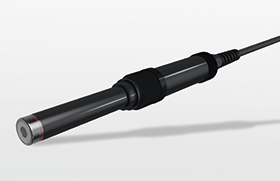Optical sensor for dissolved oxygen
April 2021
Sensors & Transducers

With its state-of-the art optical fluorescence quenching technology and digital signal processing functionality, the Jumo digiLine 0-DO S10 ensures long-term stability when measuring oxygen and temperature. Possible application areas include fish farming, sewage treatment and other sectors of water and wastewater engineering.
The sensor housing is made from tough PVC so that this Jumo digiLine can be used in both fresh and salt water. Using the innovative, user-friendly connection concept from the digiLine bus system, the device can easily and quickly be connected to the digiLine master via ‘plug and play.’ In addition, the system enables more efficient and faster cabling of plants where several parameters need to be measured simultaneously at various locations.
The device also comes with a state-of-the-art sensor management system. This system acquires and logs relevant operating data over the sensor’s entire lifecycle to optimise processes and procedures. This includes the acquisition of operating hours as well as functions designed to enable predictive maintenance such as timely notifications when calibration work is required or a sensor cap needs to be replaced.
An RS-485 Modbus RTU interface and an analog output (4-20 mA) enables easy integration into the system with field devices and process control systems. The sensor’s measuring range is 0-209 mg/l and can be used in a temperature range between -5°C and 50°C.
Further reading:
Adjustable proximity sensor with five metre range
Sensors & Transducers
The Telco line of photo-electric eyes have the accuracy and reliability you need.
Read more...
Food safety – a matter of weight
Sensors & Transducers
Weighing systems play a key role in ensuring product quality in food production, complying with legal requirements and avoiding product recalls. The Minebea Intec MiNexx portfolio has been specially developed to meet these requirements.
Read more...
Telco sensors in the paper and pulp industry
Sensors & Transducers
The paper and pulp industry poses a major problem for most photoelectric sensors. Telco Sensors has overcome this with its powerful and high-performance photoelectric sensors, ensuring penetration of thick and harsh pollution while guaranteeing reliable detection.
Read more...
Leaders in sensor technology
Sensors & Transducers
A new addition to the Telco Sensors range is the adjustable Proximity sensor, with a range up to 5 metres.
Read more...
Cutting-edge sensor technology
Endress+Hauser South Africa
Sensors & Transducers
The advantage of Endress+Hauser’s Memosens technology is that digitised measured values and sensor information are transmitted via a non-contact connection from the sensor to the cable, and as a digital signal to the transmitter.
Read more...
Miniature inductive sensors
ifm - South Africa
Sensors & Transducers
The inductive IY/IZ type sensors from ifm are used in various industrial areas where space is limited.
Read more...
The expanding role of 3D cameras in industrial quality control
TANDM Technologies
Sensors & Transducers
Across factory floors, warehouses, mines and research centres worldwide, computer vision paired with 3D camera technology is revolutionising quality control.
Read more...
PDS implementation on mines
Sensors & Transducers
Level 9 vehicle intervention for collision avoidance has been mandatory on South African mines since 2022, yet the effective roll-out of proximity detection systems remains slower than expected. This is not due to the technical limitations of integration but to operational readiness on site.
Read more...
Monitoring analogue process values
ifm - South Africa
Sensors & Transducers
Everywhere in industry, electronic sensors are used to detect process values such as temperature, pressure or flow. Process value monitoring often takes place directly in the sensor.
Read more...
Protecting buildings’ embodied carbon with retrofitted systems
Schneider Electric South Africa
Sensors & Transducers
The World Economic Forum has said that around 80% of the buildings in existence will still be around in 2050; it is therefore essential that in order to combat climate change we retrofit them for energy efficiency.
Read more...


